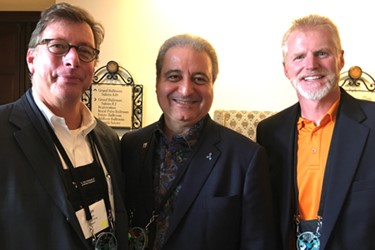The CNS Summit — A Caring Community Of Collaborative Solution Finders

By Rob Wright, Chief Editor, Life Science Leader
Follow Me On Twitter @RfwrightLSL

Usually when I return from a tradeshow or conference, one of the first things I do is write a blog about some of the things I saw and heard. But I felt this year’s CNS Summit (Oct. 29 – Nov. 1) required a period of reflection, as I needed to contemplate how to best describe what seems to make this gathering so different from all others. Because, while I thought I properly captured what the CNS Summit is after attending last year (see here), I’m not sure if I did. Or perhaps, the “show” is continuing to elevate ever higher. And while sometimes my post-event recaps attempt to capture nearly all that was said and done, somewhat along the lines of this well-written piece by Sophia Ononye (a first-time CNS Summit attendee), for me, this year anyway, that simply won’t do.
What Does The “CNS” In CNS Summit Stand For?
People have told me that they don’t attend the CNS Summit because their company isn’t focused on diseases of the central nervous system (CNS). Okay. I get that, and that would be important if the “CNS” in CNS Summit actually stood for central nervous system. But if you go to the website and look underneath the logo (top left) you will see the words, “Collaborating for Novel Solutions, Shaping the future.” But even this doesn’t truly get at the essence of the CNS Summit experience, because the “C” in CNS could also stand for “Community.” In fact, I might lobby Amir Kalali, M.D., (Twitter @akalali) the well-known industry executive who founded the CNS Summit more than 10 years ago (learn why here), to consider changing the name to C2-NS, or some other way by which “community” could be included, because it is most certainly a community of collaborators. One person captured a point of differentiation for the CNS Summit in a Tweet writing, “still buzzing from the humanity and joy of @akalali’s conference.” Have you ever heard someone use humanity and joy to describe a biopharmaceutical industry conference that you have attended? Another person posted on their LinkedIn profile, “The CNS Summit is far more than a premier #lifescience meeting. It’s a community in connection 365 days a year,” noting that the get-together is more like a reunion where everybody is welcome. To better explain it, I came up with the following scenario.
Imagine you’re driving to an important meeting and you’re running a little late. Traffic is bumper to bumper, and you seem to be hitting every possible red light. Because of construction you need to merge from three lanes down to two, but you’re sure nobody is going to let you in. Why? Because just five minutes previous you were saying out loud, “Sorry buddy, running late,” when passing on an opportunity to let a driver needing to merge do so. Now that you have that picture, let’s flip it. This time you’re driving but not pressed for time (i.e., a Sunday drive). And this time, when you see somebody needing to merge, you are the driver who leaves enough room for them to do so, even signaling the other driver by flashing your lights or using a friendly hand gesture to indicate, “come on over.” Now, if either of these driving scenarios involved attendees of the CNS Summit, here’s what would happen. The harried driver would not only find someone willing to let them merge, but these other drivers would attempt to notify other drivers of your plight so they too could try to help. For the Sunday-driver construction-merging scenario, well, there wouldn’t be traffic congestion in the first place, because all of the CNS Summit driving community would be proactively merging well ahead of time. This isn’t just because they know how to work together more collaboratively but because the majority of attendees actually care about one another and their well-being. This all goes back to the Summit’s chief curator, Amir Kalali. Because he didn’t create this conference toward be a money-making machine, but an experience, which in my opinion, is well worth experiencing. Yes. The content is exceptional, and I am humbled and honored to have been invited to take part. But it is the community of caring collaborators that make all the difference.
